Twitter’s India head Rishi Jaitly has called it the ”Twitter Election.” Indeed, according to the social media company’s own data, 56 million tweets have been sent about India’s elections between Jan. 1 and May 12, with an estimated total reach of 267 billion.
The heat map below show how India (and the world) tweeted since the beginning of the year—each color refers to the mention of one of the three major candidates: Arvind Kejriwal (green), Rahul Gandhi (blue) and Narendra Modi (orange).
[protected-iframe id=”fe9dd535587aab7f2582563e31492ae5-39587363-61658283″ info=”http://srogers.cartodb.com/viz/81916204-c392-11e3-bcbf-0e230854a1cb/embed_map?title=true&description=true&search=true&shareable=true&cartodb_logo=true&layer_selector=false&legends=true&scrollwheel=true&fullscreen=true&sublayer_options=1%7C1&sql=&sw_lat=11.821410465077479&sw_lon=60.335443281250036&ne_lat=27.525102650180578&ne_lon=99.93016984375004″ width=”100%” height=”520″ frameborder=”0″]
Click here to enlarge
While there is a certain balance between the occurrence of the three candidates in the earlier stages of the campaign, there is a net increment of tweets mentioning Narendra Modi, reflected in the progressively more orange coloring of the heat spots.
[protected-iframe id=”4b7fb8d45bfa4121f664479bf98f94a6-39587363-61658283″ info=”http://srogers.cartodb.com/viz/006e0472-da74-11e3-acea-0e10bcd91c2b/embed_map?title=true&description=true&search=true&shareable=true&cartodb_logo=true&layer_selector=false&legends=true&scrollwheel=true&fullscreen=true&sublayer_options=1%7C1&sql=&sw_lat=9.286661215316247&sw_lon=63.294111875&ne_lat=26.637816890694378&ne_lon=95.637861875″ width=”100%” height=”520″ frameborder=”0″]
Click here to enlarge
The direct comparison between volumes of tweets related mentioning the different parties shows a similar movement: from a somewhat even distribution—particularly in the mid phases of the campaign, between Jan. 28 and March 3 (before Kejriwal started his road show in Gujarat and his live Facebook talk)—but the BJP takes over in the final stages of the campaign.
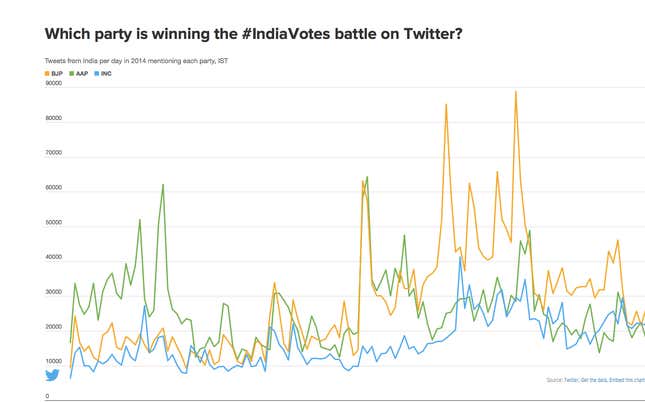
A closer look at the election-related tweets since April 7, the day after Modi’s rally in Ghaziabad, Uttar Pradesh.
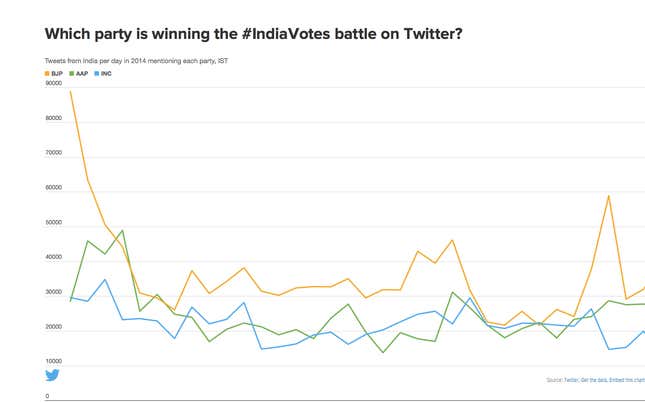
Something more interesting happens when looking specifically for the tweets related to the leader, as opposite to the party. While the overall volume of tweets mentioning Modi is comparable to those mentioning his main opponent, Rahul Gandhi, the Congress candidate’s peaks are notable particularly early in the campaign—the main one being on January 27, when “Rahul Gandhi” was mentioned 99,569 times.
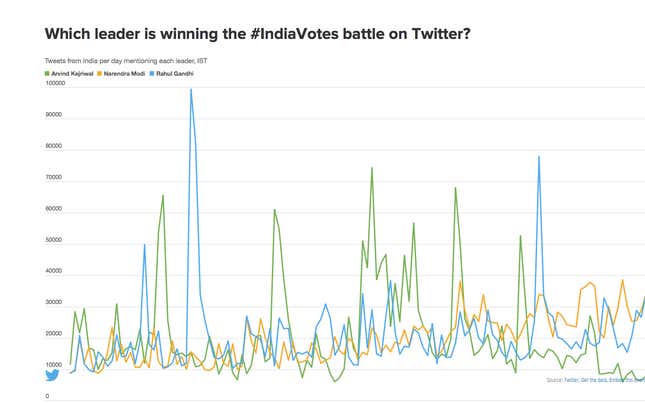
Notably, however, Rahul Gandhi doesn’t seem able to capitalize on the interest, arguably given his direct absence from Twitter: the leader of the Congress does not have an handle, unlike his adversaries, @NarendraModi and @ArvindKejriwal.
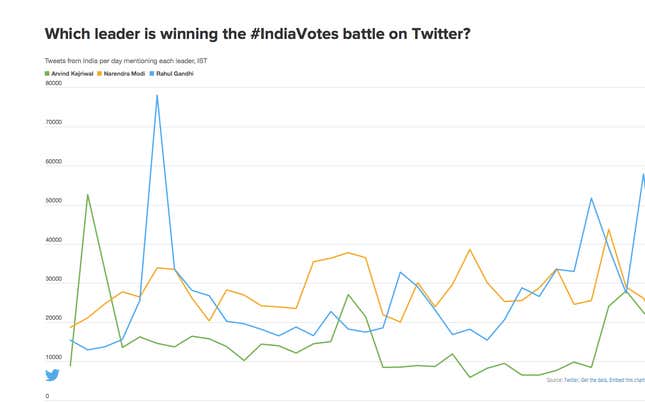
Modi’s predominance appears more clearly by comparing the occurrence of his name in election-related tweets versus other names and relevant search terms.
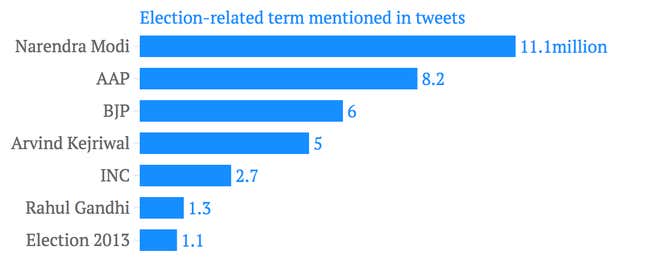
This is especially evident looking at the percentage of overall tweets about the election—Modi-related tweets are 20% of the total.
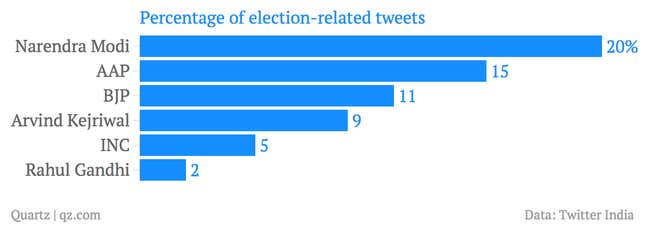
Further elements to support the predominance of the Modi discourse on Twitter can be seen in the large following of the BJP candidate’s handle: nearly 4 million accounts follow Modi, versus 1.8 million for Kejriwal (as of May 12).
Modi is also the author of one of the most retweeted tweets this election, right behind cricket superstar Sachin Tendulkar:
The little master’s tweet was retweeted 4,891 times, while the infamous “selfie with Modi” 3,751 times.
As a comparison, the most retweeted post by Arvind Kejriwal was shared 2,004 times.
All the remaining tweets amongst the 10 most-retweeted mention the BJP or Modi (or are by Modi himself), with the exception of the third most-retweeted, about the AAP:
This is not to say, however, that Modi has won the internet, or Twitter. In absolute numbers he is certainly the predominant presence, but the performance of the AAP and Kejriwal is nevertheless outstanding: from 310,392 followers on Jan. 1 to 678,934 on May 12, the @AamAadmiParty grew 119%, and @ArvindKejriwal grew 79%, going from 310,392 followers on Jan. 1 to 678,934 on May 12. Narendra Modi’s account, by comparison, only grew 28% in the same period of time.
The party that grew the most on Twitter, however, is the Indian National Congress: its Twitter handle @INCIndia went from 37,357 followers on Jan. 1 to 177,637 on May 12, with an increase of 376%. This data, while somewhat impressive, shows a party that’s much behind its opponents when it comes to social media, and possibly only capitalized by the general interest generated by the election. None of the top 10 most retweeted tweets are INC-related.